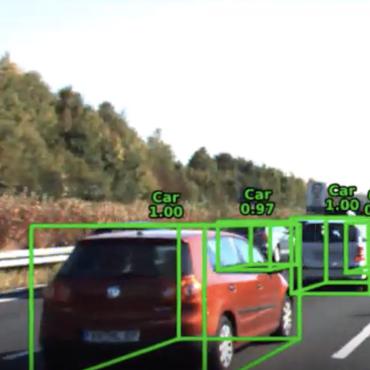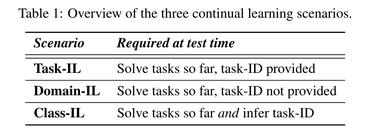Search Results for author: Jens Behley
Found 27 papers, 18 papers with code
3D LiDAR Mapping in Dynamic Environments Using a 4D Implicit Neural Representation
1 code implementation • 6 May 2024 • Xingguang Zhong, Yue Pan, Cyrill Stachniss, Jens Behley
We propose a novel approach for building accurate maps of dynamic environments utilizing a sequence of LiDAR scans.
Scaling Diffusion Models to Real-World 3D LiDAR Scene Completion
1 code implementation • 20 Mar 2024 • Lucas Nunes, Rodrigo Marcuzzi, Benedikt Mersch, Jens Behley, Cyrill Stachniss
Our experimental evaluation shows that our method can complete the scene given a single LiDAR scan as input, producing a scene with more details compared to state-of-the-art scene completion methods.
Open-World Semantic Segmentation Including Class Similarity
1 code implementation • 12 Mar 2024 • Matteo Sodano, Federico Magistri, Lucas Nunes, Jens Behley, Cyrill Stachniss
Interpreting camera data is key for autonomously acting systems, such as autonomous vehicles.
PIN-SLAM: LiDAR SLAM Using a Point-Based Implicit Neural Representation for Achieving Global Map Consistency
1 code implementation • 17 Jan 2024 • Yue Pan, Xingguang Zhong, Louis Wiesmann, Thorbjörn Posewsky, Jens Behley, Cyrill Stachniss
In this paper, we propose a SLAM system for building globally consistent maps, called PIN-SLAM, that is based on an elastic and compact point-based implicit neural map representation.
Unsupervised Pre-Training for 3D Leaf Instance Segmentation
no code implementations • 16 Jan 2024 • Gianmarco Roggiolani, Federico Magistri, Tiziano Guadagnino, Jens Behley, Cyrill Stachniss
Monitoring plants and measuring their traits is an important task in agriculture often referred to as plant phenotyping.
BonnBeetClouds3D: A Dataset Towards Point Cloud-based Organ-level Phenotyping of Sugar Beet Plants under Field Conditions
no code implementations • 22 Dec 2023 • Elias Marks, Jonas Bömer, Federico Magistri, Anurag Sah, Jens Behley, Cyrill Stachniss
Agricultural production is facing severe challenges in the next decades induced by climate change and the need for sustainability, reducing its impact on the environment.
Radar Instance Transformer: Reliable Moving Instance Segmentation in Sparse Radar Point Clouds
no code implementations • 28 Sep 2023 • Matthias Zeller, Vardeep S. Sandhu, Benedikt Mersch, Jens Behley, Michael Heidingsfeld, Cyrill Stachniss
In this paper, we address the problem of moving instance segmentation in radar point clouds to enhance scene interpretation for safety-critical tasks.
PhenoBench -- A Large Dataset and Benchmarks for Semantic Image Interpretation in the Agricultural Domain
no code implementations • 7 Jun 2023 • Jan Weyler, Federico Magistri, Elias Marks, Yue Linn Chong, Matteo Sodano, Gianmarco Roggiolani, Nived Chebrolu, Cyrill Stachniss, Jens Behley
The production of food, feed, fiber, and fuel is a key task of agriculture.
On Domain-Specific Pre-Training for Effective Semantic Perception in Agricultural Robotics
no code implementations • 22 Mar 2023 • Gianmarco Roggiolani, Federico Magistri, Tiziano Guadagnino, Jan Weyler, Giorgio Grisetti, Cyrill Stachniss, Jens Behley
Furthermore, the pre-trained networks obtain similar performance to the fully supervised with less labeled data.
Constructing Metric-Semantic Maps using Floor Plan Priors for Long-Term Indoor Localization
1 code implementation • 20 Mar 2023 • Nicky Zimmerman, Matteo Sodano, Elias Marks, Jens Behley, Cyrill Stachniss
We exploit 3D object detections from monocular RGB frames for both, the object-based map construction, and for globally localizing in the constructed map.
Panoptic Mapping with Fruit Completion and Pose Estimation for Horticultural Robots
1 code implementation • 15 Mar 2023 • Yue Pan, Federico Magistri, Thomas Läbe, Elias Marks, Claus Smitt, Chris McCool, Jens Behley, Cyrill Stachniss
Monitoring plants and fruits at high resolution play a key role in the future of agriculture.
Temporal Consistent 3D LiDAR Representation Learning for Semantic Perception in Autonomous Driving
1 code implementation • CVPR 2023 • Lucas Nunes, Louis Wiesmann, Rodrigo Marcuzzi, Xieyuanli Chen, Jens Behley, Cyrill Stachniss
Especially in autonomous driving, point clouds are sparse, and objects appearance depends on its distance from the sensor, making it harder to acquire large amounts of labeled training data.
Gaussian Radar Transformer for Semantic Segmentation in Noisy Radar Data
no code implementations • 7 Dec 2022 • Matthias Zeller, Jens Behley, Michael Heidingsfeld, Cyrill Stachniss
Scene understanding is crucial for autonomous robots in dynamic environments for making future state predictions, avoiding collisions, and path planning.
Fully On-board Low-Power Localization with Multizone Time-of-Flight Sensors on Nano-UAVs
1 code implementation • 25 Nov 2022 • Hanna Müller, Nicky Zimmerman, Tommaso Polonelli, Michele Magno, Jens Behley, Cyrill Stachniss, Luca Benini
Experimental evaluation using a nano-UAV open platform demonstrated that the proposed solution is capable of localizing on a 31. 2m$\boldsymbol{^2}$ map with 0. 15m accuracy and an above 95% success rate.
Hierarchical Approach for Joint Semantic, Plant Instance, and Leaf Instance Segmentation in the Agricultural Domain
1 code implementation • 14 Oct 2022 • Gianmarco Roggiolani, Matteo Sodano, Tiziano Guadagnino, Federico Magistri, Jens Behley, Cyrill Stachniss
In this paper, we address the problem of joint semantic, plant instance, and leaf instance segmentation of crop fields from RGB data.
Robust Double-Encoder Network for RGB-D Panoptic Segmentation
1 code implementation • 6 Oct 2022 • Matteo Sodano, Federico Magistri, Tiziano Guadagnino, Jens Behley, Cyrill Stachniss
We propose a novel encoder-decoder neural network that processes RGB and depth separately through two encoders.
IR-MCL: Implicit Representation-Based Online Global Localization
1 code implementation • 6 Oct 2022 • Haofei Kuang, Xieyuanli Chen, Tiziano Guadagnino, Nicky Zimmerman, Jens Behley, Cyrill Stachniss
The experiments suggest that the presented implicit representation is able to predict more accurate 2D LiDAR scans leading to an improved observation model for our particle filter-based localization.
SHINE-Mapping: Large-Scale 3D Mapping Using Sparse Hierarchical Implicit Neural Representations
1 code implementation • 5 Oct 2022 • Xingguang Zhong, Yue Pan, Jens Behley, Cyrill Stachniss
Accurate mapping of large-scale environments is an essential building block of most outdoor autonomous systems.
Receding Moving Object Segmentation in 3D LiDAR Data Using Sparse 4D Convolutions
1 code implementation • 8 Jun 2022 • Benedikt Mersch, Xieyuanli Chen, Ignacio Vizzo, Lucas Nunes, Jens Behley, Cyrill Stachniss
A key challenge for autonomous vehicles is to navigate in unseen dynamic environments.
Self-supervised Point Cloud Prediction Using 3D Spatio-temporal Convolutional Networks
1 code implementation • 28 Sep 2021 • Benedikt Mersch, Xieyuanli Chen, Jens Behley, Cyrill Stachniss
In this paper, we address the problem of predicting future 3D LiDAR point clouds given a sequence of past LiDAR scans.
4D Panoptic LiDAR Segmentation
1 code implementation • CVPR 2021 • Mehmet Aygün, Aljoša Ošep, Mark Weber, Maxim Maximov, Cyrill Stachniss, Jens Behley, Laura Leal-Taixé
In this paper, we propose 4D panoptic LiDAR segmentation to assign a semantic class and a temporally-consistent instance ID to a sequence of 3D points.
A Benchmark for LiDAR-based Panoptic Segmentation based on KITTI
no code implementations • 4 Mar 2020 • Jens Behley, Andres Milioto, Cyrill Stachniss
Panoptic segmentation is the recently introduced task that tackles semantic segmentation and instance segmentation jointly.
RangeNet++: Fast and Accurate LiDAR Semantic Segmentation
2 code implementations • IEEE/RSJ International Conference on Intelligent Robots and Systems (IROS) 2019 • Andres Milioto, Ignacio Vizzo, Jens Behley, Cyrill Stachniss
Perception in autonomous vehicles is often carried out through a suite of different sensing modalities.
 Ranked #19 on
Robust 3D Semantic Segmentation
on SemanticKITTI-C
Ranked #19 on
Robust 3D Semantic Segmentation
on SemanticKITTI-C
ReFusion: 3D Reconstruction in Dynamic Environments for RGB-D Cameras Exploiting Residuals
1 code implementation • 6 May 2019 • Emanuele Palazzolo, Jens Behley, Philipp Lottes, Philippe Giguère, Cyrill Stachniss
For localization and mapping, we employ an efficient direct tracking on the truncated signed distance function (TSDF) and leverage color information encoded in the TSDF to estimate the pose of the sensor.
Robotics
SemanticKITTI: A Dataset for Semantic Scene Understanding of LiDAR Sequences
5 code implementations • ICCV 2019 • Jens Behley, Martin Garbade, Andres Milioto, Jan Quenzel, Sven Behnke, Cyrill Stachniss, Juergen Gall
Despite the relevance of semantic scene understanding for this application, there is a lack of a large dataset for this task which is based on an automotive LiDAR.
 Ranked #32 on
3D Semantic Segmentation
on SemanticKITTI
Ranked #32 on
3D Semantic Segmentation
on SemanticKITTI
Fully Convolutional Networks with Sequential Information for Robust Crop and Weed Detection in Precision Farming
no code implementations • 9 Jun 2018 • Philipp Lottes, Jens Behley, Andres Milioto, Cyrill Stachniss
Exploiting the crop arrangement information that is observable from the image sequences enables our system to robustly estimate a pixel-wise labeling of the images into crop and weed, i. e., a semantic segmentation.
Joint Stem Detection and Crop-Weed Classification for Plant-specific Treatment in Precision Farming
no code implementations • 9 Jun 2018 • Philipp Lottes, Jens Behley, Nived Chebrolu, Andres Milioto, Cyrill Stachniss
It outputs the stem location for weeds, which allows for mechanical treatments, and the covered area of the weed for selective spraying.


















